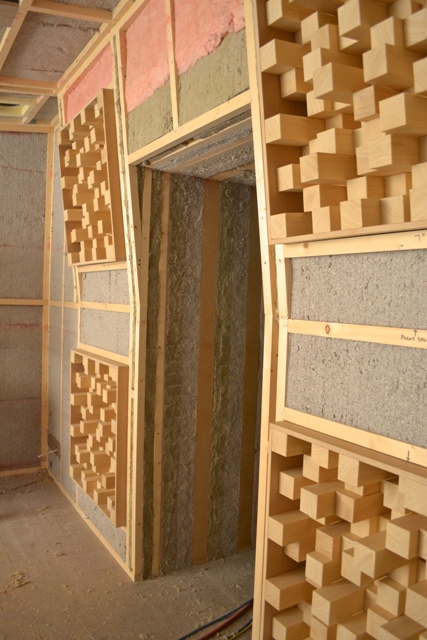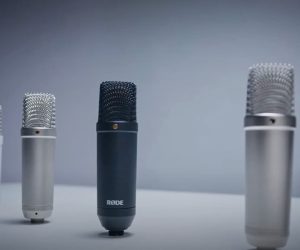
HEARING DOUBLE

When Matthew Gray is mastering in his new studio, he’ll hear a different room to what his speakers do. It’s all from the mind of next-gen acoustician/studio designer Thomas Jouanjean.
Thomas Jouanjaen’s studio design philosophy is relatively simple: Make two rooms in one. Okay, it sounds simple…
He separates the ‘church’ and ‘state’ of engineer and loudspeaker, and never the twain shall meet.
Mull on this: If you could design a space where you were absolutely sure every sound emanating from your speakers was exactly as their designer intended, what would that room look like? For a start, there would be no outside noises to contend with and no surfaces to reflect the initial sound back into that room. It would look like boundary-less space without the vacuum. Completely, acoustically dead.
But plop your ears in the same situation, and you’ll go batty in minutes. Walk down the corridors of a concert hall, or strap two pieces of foam an inch from your ears if you’re having trouble conjuring up the image. It’s disorienting to be in an environment that dead. Your brain feels uneasy when it’s not receiving feedback that your body is actually in the room, like a horseman with his head cut off.
We feel most comfortable in environments somewhere between acoustically dead and riotously loud. For instance, a lounge room has a combination of hard surfaces, bookshelves lined with gloriously diffusing literature, and sound absorbing sofas covered in throw pillows. You can easily hold a conversation without feeling like you’re in a padded cell, you might even have a nice B&O stereo… but it’s useless for critical listening (ah, the room, not the B&O gear).
Thomas’ contention is that to get the best performance out of the speakers and the engineer, they each need to effectively ‘see’, or hear, different rooms. His Front To Back (FTB) mastering suites and control rooms are the outworking of this philosophy.
HEADING NORTHWARD
Thomas’ practice, Northward Acoustics, has grown busier as audio professionals have cottoned on to his way of thinking. Like most inventors/ designers he started out as a frustrated musician and sound engineer, who always had an interest in acoustics.
He eventually studied business at university, but the bug bit him again and he dropped his MBA for a degree in acoustics and vibration engineering, immersing himself in the science of psychoacoustics and Head-Related Transfer Functions (HRTF), and starting his own company in Brussels, Belgium.
At first, he was designing rooms by the book, swallowing the paradigm of reflection-free zones hook, line and sinker. But the more he thought about it and ran into problems he couldn’t overcome, he began to realise studio designs that didn’t treat the source and the listener differently were fundamentally flawed. Hence, the development of the FTB protocol.
Since 2001, Thomas has managed over 100 projects around the world, some of his latest jobs including mastering suites for Dave Collins in Los Angeles – and coincidentally, Manley Labs’ listening room in the same facility – plus Red Bull Studios in Paris and the Noisia Studios in The Netherlands. Probably his biggest breakthrough moment was the Amsterdam Mastering room in 2009, which was his first official, fully-certified FTB, ground-up studio design.
The FTB certification is a set of rules Northward created that each of its designs has to meet.
Thomas: “We have a minimal frequency response standard. We have to be within certain boundaries, especially in the low frequencies. We must have an Energy Time Curve that shows a certain slope and a certain decay of the energy in time. It needs to show that both the speaker to room response, and engineer to room response are what they’re supposed to be. And we give a guarantee on that.”
THE FRONT TO BACK PROPOSITION
More importantly, though, is the result of these calculations and their effect on the mix.
Thomas: “To prevent any coloration occurring in the speaker-to-engineer relationship, we work with the equivalent of a non-environment — the speakers don’t see a room. It’s a very dead room in that sense. But you don’t want that for the engineer because it’s uncomfortable. You need to put the brain of an engineer at rest, not in ‘stress mode’. When you go into auditory ‘stress mode’, which is an unconscious and automated process, your brain will substantially influence the way you hear — you will emphasise environmental cues, perception of high frequencies, low frequencies, delay and reverb. Hence, you need to feed the brain the right amount of information about the environment, so we can put our hearing system in its ‘neutral mode’ — a bit like selecting our fattest ‘internal EQ’ setting.
To do that, we use self-noises — the noises that you make while working or talking in the room. We basically use surfaces that are not seen by the speaker to feed back interaction and artificial cues, triggered by these ‘self-noises’. That’s why the front wall is always reflective in our design so your brain gets some environmental data out of your interaction with it.
The diffusers in the ceiling and at the rear do the exact same thing. They are meant to interact with you and not the speakers. Everything is built around the fact that, for the speakers, there’s one room, and for the engineers there’s another.”

GRAND DESIGN
Matthew Gray Mastering commissioned Thomas to bring his brand of studio design to Australia for a completely new mastering suite in Brisbane. “His whole design principle attracted me because the room I’m in at the moment is a little bit on the dead side,” said Matt. “And if you’re not careful, you can overcompensate by adding more liveliness in the high frequencies of the mix. Thomas’ designs have ambience that sounds natural, but also very well controlled.”
Francis Manzella, who designed the extremely well-respected Sterling Sound Studios, was also on Matt’s radar. But Thomas’ enthusiasm for pushing boundaries fit well with Matt, not to mention Thomas worked to fit within the budget. Though as anyone that’s watched Grand Designs will know, having a locked-in budget or time frame is only setting yourself up for disappointment — especially when the designer has to translate his ideas into prices, materials and labour he’s never worked with before.

“We did some numbers and had an idea of roughly how much it would cost, but in reality it has cost a lot more,” said Matt. Basic construction timber was in odd sizes for Thomas, but workable and Rockwool was in ready supply. However, there were other materials completely unavailable in Australia. “The main insulation that Thomas likes to use is called Homatherm,” said Matt. “We had to get nine pallets of that sent over from Europe in a container because there wasn’t a product sold in Australia that came close. I’m glad we did, because once the walls were lined with it I could straight away hear the difference between listening to the previous Rockwool layer and the final Homatherm layer. It doesn’t sound as dead as Rockwool.”
Another hard to source material was the diffusor wood. Thomas likes to use Ayous wood, known as Obeche in Australia, because it is lightweight and stable. It’s pretty scarce, and an alternative could have been Jelutong, but Matt managed to track down some Obeche in Melbourne — enough to laser cut 874 blocks’ worth. Also, the studio bunker was decoupled using another European product called BSW Regufoam, which Thomas used because he’s more acquainted with its performance and confident of the final results.

One of the biggest hurdles was the labour. Matt found himself the right builder for the job, but problems occurred when Matt brought anyone else in to lighten the load. The standards invariably dropped, and the builder had to go back and fix issues, which inevitably cost more. Matt eventually just stuck with the original builder and the whole project has simply taken longer (the builder equated it to one man building a six-bedroom house with a couple of labourers). In the end, Matt said, “I just wanted it to be right, to be built as best as possible and we certainly got the right builder for that. He’s done an amazing job. The building’s within ±4mm of square, and that’s at eight metres diagonally across. It’s a very accurate build.”

REAL-WORLD RATIOS
Thomas doesn’t have any strict ratios he works within and his designs are never copy/paste. He would rather get the most out of a building’s floor plan and finds golden ratios tend to be of limited use in the real world.
Thomas: “In theory you want the room to have a certain ratio, but once you start to put treatment in it and work on the inner shell geometry, those ratios go out the window.”
He does however have a few considerations for studio owners to consider, and helped Matt find the right location.
Matt: “Different buildings would come up and I’d send the details to Thomas — dimensions of the space, what it’s made out of — and he’d give me feedback. We kept doing that until we found the right property and he could say, ‘This is perfect. It calculates very well. There are no compromises in the design I can do for you in this space.’”
Thomas: “There are minimal dimensions required for us to fit a room in, because of the amount of treatment that comes in and the geometry we need to fit. Another factor was the load-bearing capacity of the building. These rooms are extremely heavy — a floating control room is anywhere between 60 and 70 tonnes.”

The final choice was an industrial unit with 6.5m ceilings, dual slab, reinforced concrete walls, and dimensions that would happily contain what Thomas classifies a medium-sized room.
FALLING INTO A BIG TRAP
The first step to achieving a room that fits the formula is to eliminate modal response — in the case of studios, the modal response is the way the dimensions of the room will influence its frequency response due to interaction of sound with the room’s boundaries — in a way, its dynamic properties. A floating studio bunker is a must. Thomas always uses a floating concrete slab that also supports the rest of the structure. If the budget can stretch to it, he’ll use a custom spring setup, but in the case of Matt’s studio it was a calculated amount of BSW Regufoam that under load would give the floor a natural resonant frequency under 10Hz (he estimates 7Hz). The reason for that very low natural frequency is, you don’t want the floor to resonate at any frequency played back by the speakers.
Once the outer and inner shells are built, you need to manage the low frequencies in the room. In the case of Matt’s studio, there’s a total of eight layers of different absorbing materials and membranes that make up the rear wall, forming a massive bass trap with nothing coming back at the speakers.

Thomas: “It’s not only the back wall. It’s the side walls, the ceiling — everything is a massive bass trap. We use geometry to redirect the energy a certain way so we don’t have to use side walls that are a metre thick as well; they can be reduced to about half a metre. We tend to force the energy towards the back wall and absorb the bulk of it there. The side wall absorption will cut off at about 50–60Hz, then the back wall is the one that will go all the way to around 20Hz.”
The order of treatment differs with every project. It’ll depend on where the pressure zones are, and what kind of frequency we need to treat — some will have the Rockwool visible first, others Homatherm. Homatherm is interesting because it bridges the gap between the efficiency of Rockwool and the efficiency of membranes, which are very low frequency systems. Even though it has a rather high resistance to flow, it’ll still absorb down to about 100Hz without any problems, but will have a hole at one point where Rockwool will keep absorbing. It will pick up again where the Rockwool stops being efficient enough, but it is its mechanical behaviour that picks up, not the resistance to flow anymore. It starts to behave like a membrane.”
SPEAK UP ON CHOICE
Speaker choice is a big deal for a mastering studio and because they are the belle of the ball Thomas must get intimately acquainted with each set. Thomas has a longstanding relationship with ATC speakers. He has them in his own studio and designs with them when he can. But he knows that the engineer’s frame of reference is the most important consideration. So he’s happy to work with most high-end speaker manufacturers, including the Australian-made Duntechs that Matt’s been working on for the better part of six years. First, he has to model their behaviour.
“We get all the data we can from the manufacturer,” said Thomas. “In the case of Duntech, it was difficult. But I spoke to other engineers who had used them and could help me understand how they function — for example, they have specific dispersion characteristics. Then we estimate how the speaker is going to behave, though we can’t foresee freak behaviours. We’re pretty open to every brand, and we’ve worked with just about everything, but we also have a black list of those that do exhibit freak behaviours.
When flush-mounting speakers, we have spring-decoupled nacelles systems holding them in the front wall, which effectively stops any mechanical transmission from the speakers to the walls and structure around. It cleans up the bass response in no subtle manner. In this configuration, dispersion is also optimised. Flush-mounting is the best you can get.
In Matthew’s room we used what we call ‘quasi-flush-mounting’, with the free-standing speakers sitting right up against the wall on decoupled platforms. We need to keep the environmental cue of the front wall intact, so we must keep it reflective. But we don’t want the bass build-up and we don’t want the energy right at the back of the speaker to interact with the wall and bounce back into the room. So the wall has a density that varies and the area right behind the speaker is a complex membrane. It will absorb the energy right at the back of the speaker and let the rest of the lower frequencies go through to the big bass trap behind.
Whatever residual low frequency interaction or build up you have with the front wall will be quasi-minimum phase. The variation is so small, you can barely measure it. All in all, you have a behaviour that is quite close to in-wall mounting with only a few variations in it, keeping the front wall effectively invisible to the speakers, while maintaining the necessary environmental cues.
Though if I were to pull the speaker two metres away from the front wall, then I’d have a serious problem, because the front wall’s membrane and bass trap would not function as planned anymore and the waves would bounce a couple of metres to the wall and back – that’s four metres. There would be heavy cancellation.”
AHEAD OF THE CURVE
One of the main measuring sticks of a Front To Back success is the Energy Time Curve (ETC) response from the speaker position and from where the engineer sits.
Thomas: “Energy Time Curve is a graph that shows you how energy behaves in in the room — in amplitude against time. You will see the original burst of energy and how it decays, which helps you point out reflections that were not planned. If there is a freak reflection from a ceiling or wall, we can see it in time and see what frequency range the reflection might be in.
If I shoot the room from the main speaker position, the time it takes for the sound to decay 60dB is about 120ms in a room that size — it’s very short. And the first reflection will be, at worst, -25dB — usually they’re all under -30dB.
If I instead use a Dodecahedron omni speaker placed at a sweet spot and shoot the room again, the ETC will look completely different. There will be absolutely no similarities with the ETCs: The dodecahedron one will show me environmental cues from the ceiling diffusors, front wall — which will be pretty sharp, and the back wall diffusers — which will still be quite discrete. Basically all the environmental cues triggered by our self-noises in the room — none of these being visible in the speaker to room ETC measurement”
Matt’s room passed the tests with flying colours, and is the first certified FTB room in the country. Naturally, Matt is pretty chuffed, he’s just got to finish dressing it up, load his gear in and start mastering… no stress.

















RESPONSES